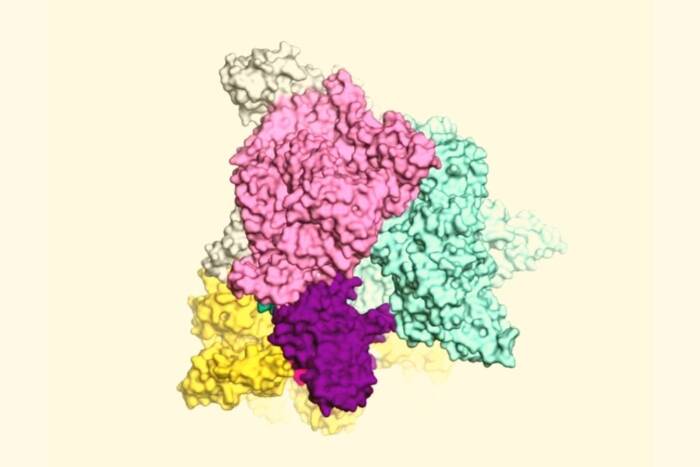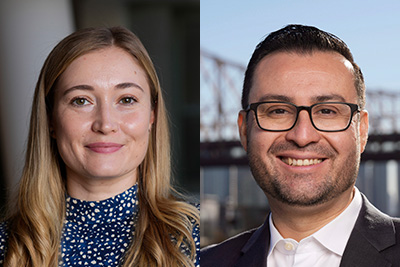With landmark gift from Kravis Foundation, construction on the river campus begins
by AMELIA KAHANEY
The first visible sign of the university’s ambitious expansion project—the construction of a new “river campus” and a 135,600 square-foot laboratory building over the FDR Drive—arrived on June 15 in the form of a small excavator and a few dozen orange and white road barriers. Tasked with laying conduit beneath the driveway in order to accommodate emergency generators that will be relocated from beside Flexner Hall, the small crew working on the driveway is one of several carrying out “enabling” projects that must be completed before work on the new campus itself can begin.

A rendering of the Marie-Josée and Henry R. Kravis Research Building, the centerpiece of the river campus extension project.
With these jobs now underway, and much of the funding for the new building in place, construction on the campus extension is set to begin by the end of the summer. The campus extension and new laboratory building are the first major construction projects at Rockefeller since Smith and Flexner Halls were renovated and the Greenberg Building erected beginning in 2008. But they will also represent a transformation of the university’s physical footprint on a scale that has not occurred since the 1950s.
“The work now underway is the first step in the reimagination of Rockefeller’s physical footprint as a twenty-first century scientific campus,” says Marc Tessier-Lavigne, the university’s president. “The extension we are building not only provides modernized lab space for our scientists but also expands and beautifies the university’s grounds and adds over two acres to the institution’s urban campus. My hope and expectation is that it will serve to stimulate and inspire a flood of biological breakthroughs over the decades to come.”
Although the concept of the river campus has been in the works since the completion of the university’s master planning process in 2013, the realization of this vision is proceeding because of three leadership gifts made by university benefactors over the winter. Twin $75 million gifts, from the Stavros Niarchos Foundation and David Rockefeller, announced in November, and a $100 million gift from The Marie-Josée and Henry R. Kravis Foundation, announced in May, mean that the first $250 million of the project’s anticipated $500 million cost is covered.
In honor of the gifts, the campus expansion will be named the Stavros Niarchos Foundation–David Rockefeller River Campus, and the laboratory building will be known as the Marie-Josée and Henry R. Kravis Research Building.
“We are deeply grateful for the extraordinary generosity of these remarkable philanthropists,” Dr. Tessier-Lavigne says. “The Marie-Josée and Henry R. Kravis Research Building, sited on the new Niarchos Foundation–Rockefeller River Campus, will help us stay at the cutting edge of scientific discovery and enable us to continue to recruit top faculty by providing them with the facilities they need to make transformative discoveries.”
Designed by Rafael Viñoly Architects, the building will house innovative laboratory space for Rockefeller’s scientific and educational programs. A unique feature of the design is an open floor plan that will provide a high degree of flexibility to accommodate the changing needs of research over time.
“The Rockefeller University is unique in that it attracts the best scientists from around the world and gives them the freedom and support to tackle the biggest questions in science,” says Henry R. Kravis, who serves as a vice chair of the university’s Board of Trustees. “Another hallmark of the university is its interdisciplinary and collaborative culture. These new laboratories have been designed to enable scientists to work seamlessly with colleagues both within and beyond their fields.”
“Stavros Niarchos and David Rockefeller were close friends and legendary business partners for over half a century,” says Andreas C. Dracopoulos, great nephew of the late Stavros Niarchos, co-president of the Stavros Niarchos Foundation, and a member of the university’s Board of Trustees. “They did well together in the twentieth century, and now they’re joining forces again to do good in the twenty-first. Under Marc Tessier-Lavigne’s visionary leadership, Rockefeller University is at the forefront of biomedical research. This support is an investment in society’s future well-being.”
“More than a century ago, my grandfather founded what is now The Rockefeller University to pursue science for the benefit of humanity,” says David Rockefeller, who has served as a trustee of the university since 1940. “Since then, the discoveries of the university’s many renowned scientists have dramatically advanced knowledge, saved countless lives and improved health worldwide. I am honored to join with the Stavros Niarchos Foundation in strengthening this great organization in the critically important work it does.”
The Stavros Niarchos Foundation–David Rockefeller River Campus will house several new buildings in addition to the Kravis Research Building, including a dining commons, an academic center, and a conference center. Associated gardens and other amenities will further enrich the university’s highly collaborative research environment.
As part of the project, the university will also improve and beautify the public esplanade adjacent to the campus for the benefit of the greater New York City community, and will make badly needed repairs to the seawall along the East River. It will also establish a fund to pay for the upkeep of the adjacent portion of the esplanade in perpetuity.
A timeline for the project’s work calls for the excavation of the courtyards on either side of Welch Hall to begin by September. These areas will become mechanical rooms to serve the new building, and the landscaping will eventually be replaced. By next spring, excavation will start on the extension’s east column footings, and later in 2016 installation of prefabricated sections of the building superstructure will occur; these will be installed by crane barges working from the river. Completion of the Stavros Niarchos Foundation–David Rockefeller River Campus is anticipated in early 2019.
For more information on the project, including a video and detailed timeline, visit: snf-dr-rivercampus.rockefeller.edu.


